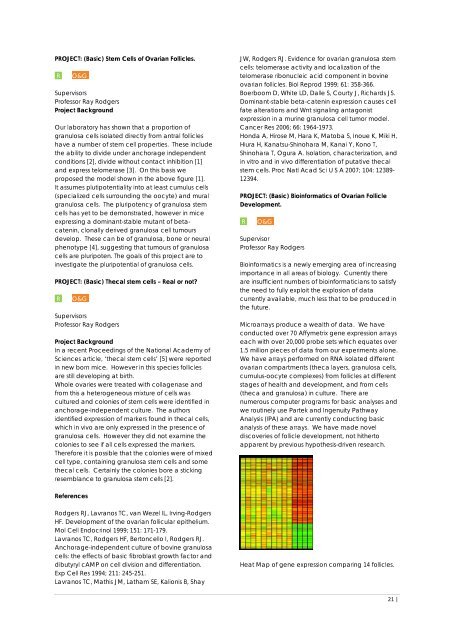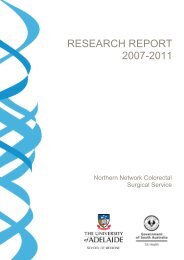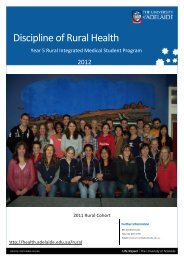Honours Project Book - Faculty of Health Sciences - University of ...
Honours Project Book - Faculty of Health Sciences - University of ...
Honours Project Book - Faculty of Health Sciences - University of ...
Create successful ePaper yourself
Turn your PDF publications into a flip-book with our unique Google optimized e-Paper software.
PROJECT: (Basic) Stem Cells <strong>of</strong> Ovarian Follicles.<br />
R. O&G.<br />
Supervisors<br />
Pr<strong>of</strong>essor Ray Rodgers<br />
<strong>Project</strong> Background<br />
Our laboratory has shown that a proportion <strong>of</strong><br />
granulosa cells isolated directly from antral follicles<br />
have a number <strong>of</strong> stem cell properties. These include<br />
the ability to divide under anchorage independent<br />
conditions [2], divide without contact inhibition [1]<br />
and express telomerase [3]. On this basis we<br />
proposed the model shown in the above figure [1].<br />
It assumes plutipotentiality into at least cumulus cells<br />
(specialized cells surrounding the oocyte) and mural<br />
granulosa cells. The pluripotency <strong>of</strong> granulosa stem<br />
cells has yet to be demonstrated, however in mice<br />
expressing a dominant-stable mutant <strong>of</strong> betacatenin,<br />
clonally derived granulosa cell tumours<br />
develop. These can be <strong>of</strong> granulosa, bone or neural<br />
phenotype [4], suggesting that tumours <strong>of</strong> granulosa<br />
cells are pluripoten. The goals <strong>of</strong> this project are to<br />
investigate the pluripotential <strong>of</strong> granulosa cells.<br />
PROJECT: (Basic) Thecal stem cells – Real or not?<br />
R. O&G.<br />
Supervisors<br />
Pr<strong>of</strong>essor Ray Rodgers<br />
<strong>Project</strong> Background<br />
In a recent Proceedings <strong>of</strong> the National Academy <strong>of</strong><br />
<strong>Sciences</strong> article, ‘thecal stem cells’ [5] were reported<br />
in new born mice. However in this species follicles<br />
are still developing at birth.<br />
Whole ovaries were treated with collagenase and<br />
from this a heterogeneous mixture <strong>of</strong> cells was<br />
cultured and colonies <strong>of</strong> stem cells were identified in<br />
anchorage-independent culture. The authors<br />
identified expression <strong>of</strong> markers found in thecal cells,<br />
which in vivo are only expressed in the presence <strong>of</strong><br />
granulosa cells. However they did not examine the<br />
colonies to see if all cells expressed the markers.<br />
Therefore it is possible that the colonies were <strong>of</strong> mixed<br />
cell type, containing granulosa stem cells and some<br />
thecal cells. Certainly the colonies bore a sticking<br />
resemblance to granulosa stem cells [2].<br />
References<br />
Rodgers RJ, Lavranos TC, van Wezel IL, Irving-Rodgers<br />
HF. Development <strong>of</strong> the ovarian follicular epithelium.<br />
Mol Cell Endocrinol 1999; 151: 171-179.<br />
Lavranos TC, Rodgers HF, Bertoncello I, Rodgers RJ.<br />
Anchorage-independent culture <strong>of</strong> bovine granulosa<br />
cells: the effects <strong>of</strong> basic fibroblast growth factor and<br />
dibutyryl cAMP on cell division and differentiation.<br />
Exp Cell Res 1994; 211: 245-251.<br />
Lavranos TC, Mathis JM, Latham SE, Kalionis B, Shay<br />
JW, Rodgers RJ. Evidence for ovarian granulosa stem<br />
cells: telomerase activity and localization <strong>of</strong> the<br />
telomerase ribonucleic acid component in bovine<br />
ovarian follicles. Biol Reprod 1999; 61: 358-366.<br />
Boerboom D, White LD, Dalle S, Courty J, Richards JS.<br />
Dominant-stable beta-catenin expression causes cell<br />
fate alterations and Wnt signaling antagonist<br />
expression in a murine granulosa cell tumor model.<br />
Cancer Res 2006; 66: 1964-1973.<br />
Honda A, Hirose M, Hara K, Matoba S, Inoue K, Miki H,<br />
Hiura H, Kanatsu-Shinohara M, Kanai Y, Kono T,<br />
Shinohara T, Ogura A. Isolation, characterization, and<br />
in vitro and in vivo differentiation <strong>of</strong> putative thecal<br />
stem cells. Proc Natl Acad Sci U S A 2007; 104: 12389-<br />
12394.<br />
PROJECT: (Basic) Bioinformatics <strong>of</strong> Ovarian Follicle<br />
Development.<br />
R. O&G.<br />
Supervisor<br />
Pr<strong>of</strong>essor Ray Rodgers<br />
Bioinformatics is a newly emerging area <strong>of</strong> increasing<br />
importance in all areas <strong>of</strong> biology. Currently there<br />
are insufficient numbers <strong>of</strong> bioinformaticians to satisfy<br />
the need to fully exploit the explosion <strong>of</strong> data<br />
currently available, much less that to be produced in<br />
the future.<br />
Microarrays produce a wealth <strong>of</strong> data. We have<br />
conducted over 70 Affymetrix gene expression arrays<br />
each with over 20,000 probe sets which equates over<br />
1.5 million pieces <strong>of</strong> data from our experiments alone.<br />
We have arrays performed on RNA isolated different<br />
ovarian compartments (theca layers, granulosa cells,<br />
cumulus-oocyte complexes) from follicles at different<br />
stages <strong>of</strong> health and development, and from cells<br />
(theca and granulosa) in culture. There are<br />
numerous computer programs for basic analyses and<br />
we routinely use Partek and Ingenuity Pathway<br />
Analysis (IPA) and are currently conducting basic<br />
analysis <strong>of</strong> these arrays. We have made novel<br />
discoveries <strong>of</strong> follicle development, not hitherto<br />
apparent by previous hypothesis-driven research.<br />
Heat Map <strong>of</strong> gene expression comparing 14 follicles.<br />
21 |





